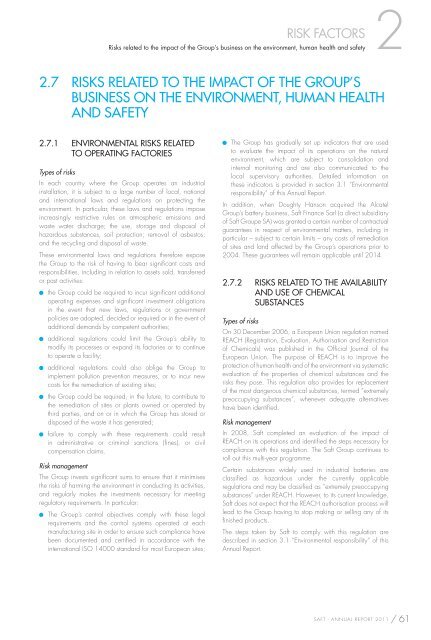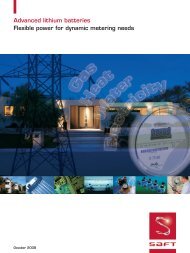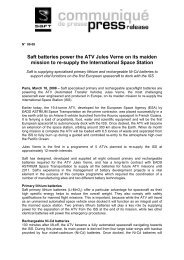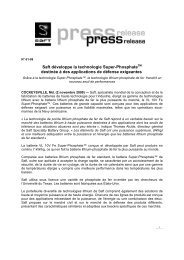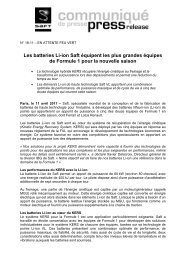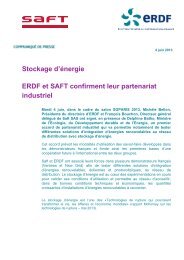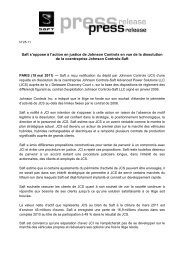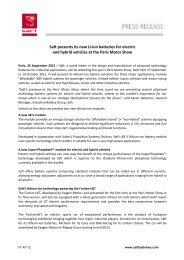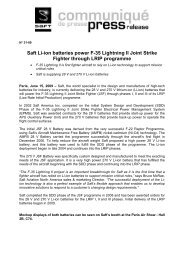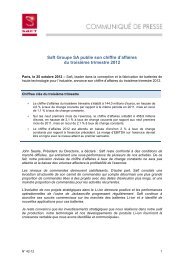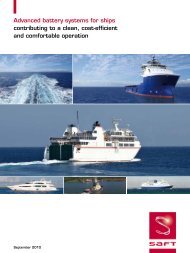ANNUAL REPORT 2011 REGISTRATION DOCUMENT - Saft
ANNUAL REPORT 2011 REGISTRATION DOCUMENT - Saft
ANNUAL REPORT 2011 REGISTRATION DOCUMENT - Saft
You also want an ePaper? Increase the reach of your titles
YUMPU automatically turns print PDFs into web optimized ePapers that Google loves.
RISK FACTORS 2<br />
Risks related to the impact of the Group’s business on the environment, human health and safety<br />
2.7 RISKS RELATED TO THE IMPACT OF THE GROUP’S<br />
BUSINESS ON THE ENVIRONMENT, HUMAN HEALTH<br />
AND SAFETY<br />
2.7.1 ENVIRONMENTAL RISKS RELATED<br />
TO OPERATING FACTORIES<br />
Types of risks<br />
In each country where the Group operates an industrial<br />
installation, it is subject to a large number of local, national<br />
and international laws and regulations on protecting the<br />
environment. In particular, these laws and regulations impose<br />
increasingly restrictive rules on atmospheric emissions and<br />
waste water discharge; the use, storage and disposal of<br />
hazardous substances, soil protection; removal of asbestos;<br />
and the recycling and disposal of waste.<br />
These environmental laws and regulations therefore expose<br />
the Group to the risk of having to bear signifi cant costs and<br />
responsibilities, including in relation to assets sold, transferred<br />
or past activities:<br />
� the Group could be required to incur signifi cant additional<br />
operating expenses and signifi cant investment obligations<br />
in the event that new laws, regulations or government<br />
policies are adopted, decided or required or in the event of<br />
additional demands by competent authorities;<br />
� additional regulations could limit the Group’s ability to<br />
modify its processes or expand its factories or to continue<br />
to operate a facility;<br />
� additional regulations could also oblige the Group to<br />
implement pollution prevention measures, or to incur new<br />
costs for the remediation of existing sites;<br />
� the Group could be required, in the future, to contribute to<br />
the remediation of sites or plants owned or operated by<br />
third parties, and on or in which the Group has stored or<br />
disposed of the waste it has generated;<br />
� failure to comply with these requirements could result<br />
in administrative or criminal sanctions (fi nes), or civil<br />
compensation claims.<br />
Risk management<br />
The Group invests signifi cant sums to ensure that it minimises<br />
the risks of harming the environment in conducting its activities,<br />
and regularly makes the investments necessary for meeting<br />
regulatory requirements. In particular:<br />
� The Group’s central objectives comply with these legal<br />
requirements and the control systems operated at each<br />
manufacturing site in order to ensure such compliance have<br />
been documented and certifi ed in accordance with the<br />
international ISO 14000 standard for most European sites;<br />
� The Group has gradually set up indicators that are used<br />
to evaluate the impact of its operations on the natural<br />
environment, which are subject to consolidation and<br />
internal monitoring and are also communicated to the<br />
local supervisory authorities. Detailed information on<br />
these indicators is provided in section 3.1 “Environmental<br />
responsibility” of this Annual Report.<br />
In addition, when Doughty Hanson acquired the Alcatel<br />
Group’s battery business, <strong>Saft</strong> Finance Sarl (a direct subsidiary<br />
of <strong>Saft</strong> Groupe SA) was granted a certain number of contractual<br />
guarantees in respect of environmental matters, including in<br />
particular – subject to certain limits – any costs of remediation<br />
of sites and land affected by the Group’s operations prior to<br />
2004. These guarantees will remain applicable until 2014.<br />
2.7.2 RISKS RELATED TO THE AVAILABILITY<br />
AND USE OF CHEMICAL<br />
SUBSTANCES<br />
Types of risks<br />
On 30 December 2006, a European Union regulation named<br />
REACH (Registration, Evaluation, Authorisation and Restriction<br />
of Chemicals) was published in the Offi cial Journal of the<br />
European Union. The purpose of REACH is to improve the<br />
protection of human health and of the environment via systematic<br />
evaluation of the properties of chemical substances and the<br />
risks they pose. This regulation also provides for replacement<br />
of the most dangerous chemical substances, termed “extremely<br />
preoccupying substances”, whenever adequate alternatives<br />
have been identifi ed.<br />
Risk management<br />
In 2008, <strong>Saft</strong> completed an evaluation of the impact of<br />
REACH on its operations and identifi ed the steps necessary for<br />
compliance with this regulation. The <strong>Saft</strong> Group continues to<br />
roll out this multi-year programme.<br />
Certain substances widely used in industrial batteries are<br />
classifi ed as hazardous under the currently applicable<br />
regulations and may be classifi ed as “extremely preoccupying<br />
substances” under REACH. However, to its current knowledge,<br />
<strong>Saft</strong> does not expect that the REACH authorisation process will<br />
lead to the Group having to stop making or selling any of its<br />
fi nished products.<br />
The steps taken by <strong>Saft</strong> to comply with this regulation are<br />
described in section 3.1 “Environmental responsibility” of this<br />
Annual Report.<br />
SAFT - <strong>ANNUAL</strong> <strong>REPORT</strong> <strong>2011</strong> / 61


